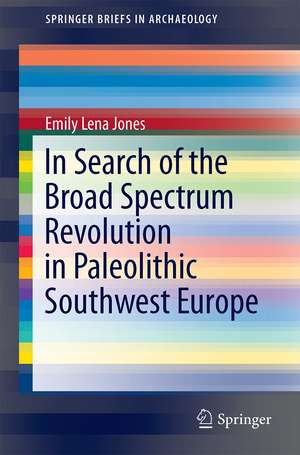In Search of the Broad Spectrum Revolution in Paleolithic Southwest Europe: SpringerBriefs in Archaeology
Autor Emily Lena Jonesen Limba Engleză Paperback – 15 oct 2015
This volume explores these questions, along the way delving into the history of the “bigger equals better” assumption; optimal foraging theory and niche construction theory; and patterns of environmental and subsistence change across the Pleistocene-Holocene transition.
Din seria SpringerBriefs in Archaeology
-
 Preț: 447.84 lei
Preț: 447.84 lei -
 Preț: 382.95 lei
Preț: 382.95 lei -
 Preț: 381.00 lei
Preț: 381.00 lei -
 Preț: 386.22 lei
Preț: 386.22 lei -
 Preț: 379.68 lei
Preț: 379.68 lei -
 Preț: 381.00 lei
Preț: 381.00 lei -
 Preț: 378.71 lei
Preț: 378.71 lei -
 Preț: 381.81 lei
Preț: 381.81 lei - 15%
 Preț: 470.24 lei
Preț: 470.24 lei -
 Preț: 411.32 lei
Preț: 411.32 lei -
 Preț: 381.21 lei
Preț: 381.21 lei -
 Preț: 382.95 lei
Preț: 382.95 lei -
 Preț: 448.38 lei
Preț: 448.38 lei -
 Preț: 377.35 lei
Preț: 377.35 lei -
 Preț: 448.28 lei
Preț: 448.28 lei -
 Preț: 380.84 lei
Preț: 380.84 lei -
 Preț: 379.86 lei
Preț: 379.86 lei -
 Preț: 445.33 lei
Preț: 445.33 lei -
 Preț: 413.45 lei
Preț: 413.45 lei -
 Preț: 406.79 lei
Preț: 406.79 lei -
 Preț: 412.13 lei
Preț: 412.13 lei -
 Preț: 420.68 lei
Preț: 420.68 lei -
 Preț: 457.35 lei
Preț: 457.35 lei - 20%
 Preț: 386.76 lei
Preț: 386.76 lei -
 Preț: 316.95 lei
Preț: 316.95 lei -
 Preț: 281.65 lei
Preț: 281.65 lei -
 Preț: 349.47 lei
Preț: 349.47 lei -
 Preț: 377.18 lei
Preț: 377.18 lei -
 Preț: 381.98 lei
Preț: 381.98 lei -
 Preț: 487.37 lei
Preț: 487.37 lei -
 Preț: 381.00 lei
Preț: 381.00 lei -
 Preț: 381.00 lei
Preț: 381.00 lei
Preț: 377.18 lei
Nou
Puncte Express: 566
Preț estimativ în valută:
72.17€ • 75.36$ • 59.60£
72.17€ • 75.36$ • 59.60£
Carte tipărită la comandă
Livrare economică 15-29 aprilie
Preluare comenzi: 021 569.72.76
Specificații
ISBN-13: 9783319223506
ISBN-10: 331922350X
Pagini: 91
Ilustrații: IX, 91 p. 17 illus., 6 illus. in color.
Dimensiuni: 155 x 235 x 10 mm
Greutate: 0.16 kg
Ediția:1st ed. 2016
Editura: Springer International Publishing
Colecția Springer
Seria SpringerBriefs in Archaeology
Locul publicării:Cham, Switzerland
ISBN-10: 331922350X
Pagini: 91
Ilustrații: IX, 91 p. 17 illus., 6 illus. in color.
Dimensiuni: 155 x 235 x 10 mm
Greutate: 0.16 kg
Ediția:1st ed. 2016
Editura: Springer International Publishing
Colecția Springer
Seria SpringerBriefs in Archaeology
Locul publicării:Cham, Switzerland
Public țintă
ResearchCuprins
Chapter 1: Paleolithic people, Paleolithic landscapes.- Chapter 2: Big game, small game: why it matters.- Chapter 3: Climate and environment in Late Paleolithic Southwestern Europe.- Chapter 4: Human subsistence and the archaeofaunal record of Late Paleolithic Southwest Europe.- Chapter 5: Archaeofaunal diversity and broad spectrum diets in Late Paleolithic Southwest Europe.- Chapter 6: Was there a Broad Spectrum Revolution in Southwest Europe?.
Notă biografică
Emily Lena Jones is Assistant Professor of Anthropology at University of New Mexico. A zooarchaeologist and environmental archaeologist, her research focuses on human-environment interactions, particularly human responses to climate change and landscape variability. She has worked in the Paleolithic of Southwestern Europe for over fifteen years.
Caracteristici
Explains the logic of the foraging theory and its proposed alternative, the niche construction theory Explores the subsistence and settlement behavior of hunter-gatherers in various environments Discusses the current state of Broad Spectrum Revolution research by introducing paleoenvironmental data in addition tolandscape analysis and zooarchaeology






